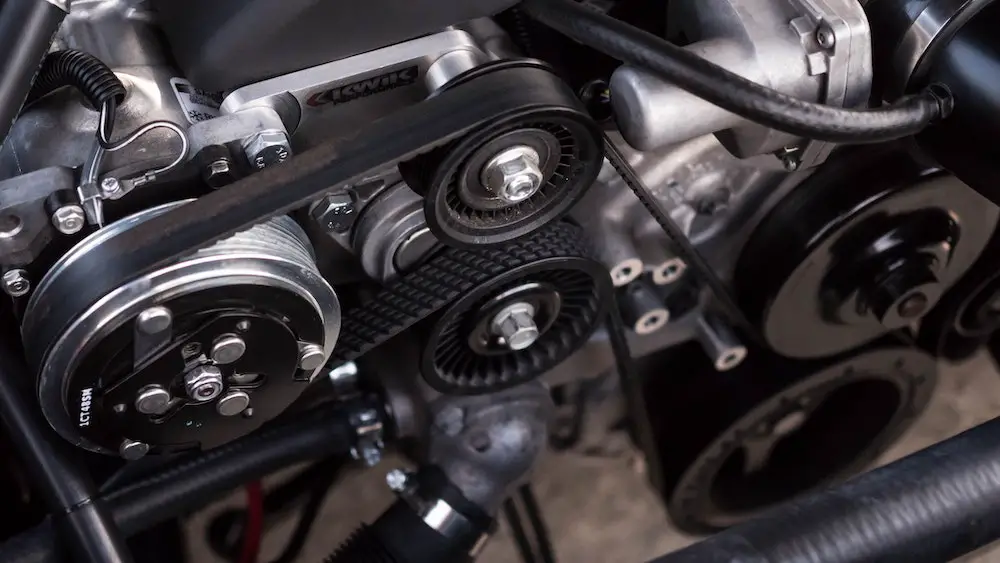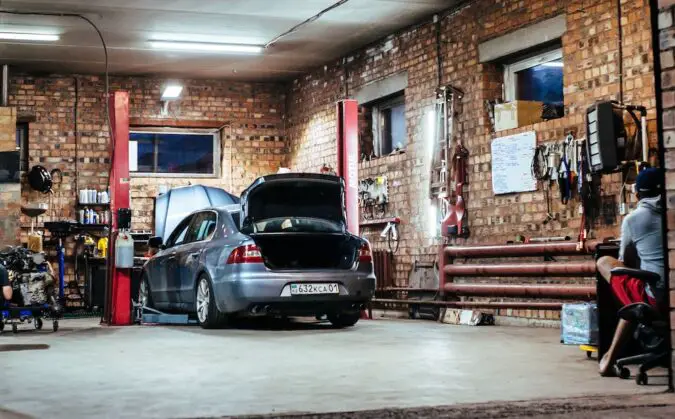Are you hearing some weird squealing noises when you start your engine? If this is the case then you are probably having a problem with some of the pulleys on your car. Most likely with the idler pulley. But you shouldn’t worry because we are going to help you out with this problem.
Having a problem like this to deal with can be frustrating and also quite dangerous. But why is this the case? Well, this is the case because the sounds that you will hear will be unbearable to tolerate for a long time. Nobody wants to hear squealing noises coming from the front hood. And no matter how well insulated your car is, the sound will still be there to remind you that something is wrong with your car.
Another thing is safety. When a car has a problem like this, then it is highly likely that the safety of your vehicle would be in danger. These pulleys are not working right and the belt is loose, it could jump or the pulley can get damaged and all the accessories in your car to shut off. That’s why you need to educate yourself on this topic and learn if your pulley is the problem, or possibly the belt. And we are going to help you out with that.
First, we are going to start from the basics and learn what are the characteristics of the idler pulley and how many pulleys a car has. Then we will learn the reasons why these pulleys fail and the signs when they produce when they break. Later we will focus on diagnosing and solving the issue. So, follow along if you want to learn more.
What Is An Idler Pulley?
Before we delve into the reasons why idler pulleys break and the signs or symptoms they produce when this happens. Let’s first learn what is an idler pulley in general. We need to start from somewhere and the basics are probably the perfect starting point. Since not all that will read this text are car guys and experienced to tackle these problems. So, if you want to learn more, keep up with us, if not, jump to the reasons and symptoms.
Nevertheless, an idler pulley is simply a wheel that is rotating around a shaft or an axle. The idea of a pulley has a long history. Everything started in Ancient Egypt. More precisely about 4000 years ago. The pulleys were used about that time on simple machines for lifting.
Then they saw a big use in the boating industry where they were used on ships to lift the sails on the mast. You have probably seen the Pirates From the Caribbean movie. So, you get my point. Pulleys are massively used on these ships.
But they also saw wide use in the industrialization processes. Most notably in the automotive industry where pulleys are one of the irreplaceable components in our motor vehicles. These pulleys have a really simple role in automobiles. They transfer the rotational force of the crankshaft wherever there is need with the help of the drive belt and also keep tension on the drive belt.
The drive belt is routed through more than a few pulleys for this energy to be used sustainably and all these accessories to function right. But have you asked yourself how many idler pulleys there are in a car? Well, that’s what we are going to cover next.
How Many Pulleys Does An Engine Have?
We have covered the basics of what pulleys are and also what is an idler pulley. We can conclude that the idler pulley is a pulley that is holding tension on the drive belt and also transferring the rotational energy from the crankshaft to the other accessories. Thus it got the name idler pulley because it doesn’t produce and doesn’t waste energy. It just transfers the energy through the different components.
But have you asked yourself how many pulleys and idler pulleys are there inside of the engine bay? Let’s elaborate on this in-depth because a lot of people are confused sometimes by these terms.
The biggest pulley inside of an engine is the one on the crankshaft. This pulley is usually located down in the center of the block.
The second most important is the alternator. This pulley is powering the alternator which as we know is the component that is generating electricity inside and is charging the battery and powering the accessories inside of the cabin.
Then there is the AC pulley that is powering the air conditioning system if there is an AC in the car. There is also a power steering pulley that is powering the power steering system. And the last probably is the water pump. All these components have pulleys. But the main power source comes from the crankshaft that is located down the center.
These pulleys that we mentioned are not idler pulleys but pulleys that serve a role of creating energy and this rotational energy is used by some of the components.
The idler pulley once again is only there to keep tension and transfer this energy to the different pulleys. Most engines have one idler pulley but some even have two, like in Subaru engines.
Reasons Why The Pulley Fails
We covered the idler pulley and we learned that this pulley has a specific role to make tension on the belt as well as to transfer the belt energy and power the accessories inside of your car.
But what causes the pulley to fail? What are the prime reasons for this unfortunate event to happen and make you spend money on mechanics that you really don’t want to spend? Let’s elaborate.
Wear And Tear
The first probable cause why the idler pulley wears is the overall wear and tear. As you know, this pulley is too stressed out. Meaning that during its life is transferring a lot of energy to the accessories and keeping the tension of the belt in the process.
All, these things attribute to the failure of these pulleys. That’s why these pulleys are required to be replaced every 50,000 miles or so. Usually, whenever you replace your drive belt you should replace the pulley as well. The bearings inside wear down and a pulley with new bearings is not the same as a reused pulley with an old bearing.
Some people though are trying to go on the cheaper route and not replace these pulleys. They replace only the belt and soon after the belt is starting to produce symptoms or even fails. All this is because of a cheap idler pulley that they didn’t replace.
So, it is quite an essential thing for you to replace your pulley every 50,000 miles when you do the driving belt replacement. If not, you will have problems sooner or later.
Bad Build Quality
Another reason why the idler pulley fails is the poor build quality. Some manufacturers simply use poor quality bearings inside of these pulleys and this could attribute to their eventual failure. When the bearing fails, it is simply a matter of time when the belt will start to squeal or come off.
That’s why when you purchase these pulleys. Make sure that you get ones from a reputable seller and a good brand. You don’t want to do this work twice. It is not cheap to do this work all over again.
Also, in some cases, even the pulley material could be really bad and wear too quickly. This is also a bad situation that you want to avoid. So, get better quality parts if you want to pay twice for the work.
Idler Pulley Slippage
We mentioned the wear of the outside of the idler pulley in the previous chapter and now elaborate on this topic in-depth. This situation when the idler pulley is too worn is also known as idler pulley slippage.
This means that the pulley slips instead of gripping the belt. This will attribute to developing symptoms that we are going to cover in the following chapters.
The important thing is to be aware of this problem. This slippage is real and happens quite often on cars that haven’t been serviced and their pulleys and belts haven’t been replaced on time. This also will attribute to your vehicle’s overall poor work and lack of performance. Now let’s discuss the last symptom.
Damage To The Pulley
We discussed the wear of the idler pulley and now let’s discuss the complete failure of this component. These pulleys also tend to catastrophically fail.
Meaning that the whole idler pulley will fail completely on your car and the belt would jump and all of your accessories will fail.
This often happens on cars that were not serviced and the idler pulley that was made out of cheap plastic simply cracked and separated in two. In these situations, only the bearing will be left but this will not be able to keep the tension on the belt. So, when this happens often the belt loses tension and your accessories are done.
This means, no AC, no alternator, no water pump, no power steering. You are basically left without the essentials for your car to work and the only way around this problem would be to call a tow service and tow your car to the nearest shop.
Because if you drive the car like this is not possible. There will be no power produced to power the spark plugs. Overall, that’s all on the reasons why this idler pulley fails. Now, let’s cover the symptoms how you can detect the problem.
Symptoms Of Bad Idler Pulley
We learned what is an idler pulley and what is its role. Then we covered the reasons why this pulley fails. The most common reasons as we noted are the high mileage, low-quality materials used in building this pulley, and overall poor craftsmanship.
That’s why it is often recommended to purchase quality parts for your car if you don’t want to experience this problem and the idler pulley symptoms that we are going to cover in the following chapters. So, this chapter will be the key to diagnosing the problem based on the symptoms. Now let’s elaborate on them.
1. Squealing Noises Coming From The Front Of The Car
One of the first symptoms that you will notice when the idler pulley is failing are the squealing sounds coming from the engine bay.
These sounds are the most common symptom of this problem. Whenever you start the engine and it works at idle speed at 800 RPM approximately, the drive belt would produce a squealing sound and will piss you off.
This sound is often can disappear and make you think that you don’t have a problem anymore. But that is not until the next morning when you perform a cold start and the belt starts squealing again.
There is no solution for this problem unless it is checked and the belt either tightened or replaced. As well as the idler pulley which as we said should be replaced every time when you are performing a drive belt replacement.
2. Play In The Pulley
Another symptom of a bad idler pulley that we are going to cover is the symptom when there is a play in the pulley. So, how you can check if there is play in the pulley? It is quite simple though.
Just start your car and leave it running. Then open your hood and see how the belt is behaving. Tell a friend or your wife to press the gas pedal and give the engine some revs.
If in this situation there are wobbles and the pulley moves left or right. Then this pulley is probably due to be replaced soon.
This is a clear example of how the pulley shouldn’t work. So, whenever you notice this, then it is time to replace it.
Also, you can turn the engine off and give the pulley a little wiggle. If it moves, then it is due to be replaced. Basically, this is causing your problem. But later in the diagnosing chapter, we are going to elaborate on this in-depth.
3. Visible Damage To The Pulley
The third and last symptom that we are going to cover is the symptom when there is visible damage or separation on the pulley.
Notice if there are cracks on the pulley, visible wear on the position where the belt is sitting. If there is something that is not normal, then you know that the idler pulley needs to be replaced.
This is also essential because if there is too much damage the component could fail completely. Causing a lot of headaches if this situation happens.
You will be left without your accessories in the car and the engine will simply shut down. It is a not dangerous situation like when a timing belt fails. But still is something that could in the least make your car undrivable for a while and will have to be towed on a truck.
So, when it comes to avoiding situations like this. It is time to learn how to diagnose the problem. Knowing how to diagnose the issue will save you a ton of nerves and time. So, if you want to know how it is done, follow along.
How To Diagnose A Bad Idler Pulley?
We covered everything, we learned what is an idler pulley, then we learned the reasons why it is failing and the symptoms that it produces. As we noted, there are a number of symptoms that are present when there is a problem with the pulley.
The most notable symptom is the whining noise that often happens when these pulleys are broken or worn out. Then there is the play that they develop and love to wobble when you press on the gas.
So, this is a good test to determine a bad pulley. Start your car and press on the gas. Observe all of the pulleys and see if there are some pulleys that move the belt in and out when under heavy load. This is a simple way how you can determine if a pulley is broken. The other way is to perform a visual inspection and see if there is some problem.
But there is also another way that you can pull off. And that is by using a screwdriver. For this purpose, you will need one long screwdriver and a plastic bottle.
You need to cut the plastic bottle in half and connect the threads with the screwdriver. Then start the engine and the following step is key for making this operation a success.
And that is to stick the screwdriver against all of these components that have pulleys. Just not on the belt, you don’t want to hurt yourself.
If there is a bad pulley, there will be an unpleasant sound that will be created. The plastic bottle is simply amplifying the sound that the pulleys are producing. So, you might be hearing some weird noises if they are bad. But how to replace one?
How To Replace An Idler Pulley?
Replacing an idler pulley is dead-easy and could be done in a half an hour. It is not a demanding job if you already diagnosed the problem. For this job, you will need a ratchet or a wrench with the right socket, a new idler pulley, and a pulley tensioner bar to remove the tension on the belt in order to remove the pulley.
The first thing you will need is to remove the tension from the belt if you want to remove the pulley. Then you move on to the next step and that is replacing the pulley.
After this, you repeat the process and mount the new part and restore the tension on the belt. Overall, a simple job. In the video that we attached, you can check how this process is done the right way in a few minutes. But what is the total cost for this job? Let’s elaborate in the following chapter.
Cost To Replace An Idler Pulley
Now let’s discuss the cost of replacing this part. The average cost if you have all the tooling necessary and you know how to do it is about $30 for a new idler pulley.
But if you go to a shop and replace the component there, you can expect to pay a lot more money than the part costs. At a shop, you will probably pay more than $150 for this work.
As you know, labor is expensive and this is one of the prices that you pay when you don’t have tools at home to perform this work. But when considering everything, the best would be to replace the drive belt as well and sort out any other pulleys that are producing problems.
By doing this, you will make sure that you will not experience problems in the near future.
Can I Keep Driving Like This?
Can you keep driving with a bad idler pulley? Well, technically, you can. But that doesn’t mean that this is a recommended practice to do.
A bad idler pulley can run for more than 10,000 miles or more. But the symptoms that it produces are terrible, your ears will say thank you when you fix this problem.
And eventually, if the component fails completely, the belt could fall off and you will lose all the accessories and the engine will eventually shut down. So, considering all this, running your engine with this problem is not recommended. This is not an expensive repair and could be done fairly cheaply. That’s why don’t delay it.
Idler Pulleys – What You Need to Know:
- Idler pulleys are responsible for guiding and tensioning the engine drive belts in most engines, providing a smoothly rotating point for the belt to loop around.
- Engines usually use one idler pulley and one tensioner pulley, though some designs use more than one idler.
- Over time, idler pulleys will wear out and need to be replaced, which may lead to reduced tension and belt slipping.
- Visible scoring marks on the surface of the pulley may occur as a result of contact with the belt.
- Squealing from the engine belts may occur if the pulley wears or binds against the belt.
- A damaged bearing or pulley is a more serious symptom that may cause the belt to fall off the engine, leading to overheating and stalling.
- Idler pulleys are a common component found in most vehicles and require replacement, especially in high-mileage vehicles.
- Any engine pulleys are crucial to the overall operation of the engine, as the serpentine belt and pulleys allow the engine to function properly after starting.
- The cost of inspecting and replacing idler pulleys can vary depending on the make and model of the vehicle.
- Regular inspection and replacement of idler pulleys can prevent engine belt failure and costly repairs.
Conclusion To Idler Pulley
In this article, we have covered quite a bit when it comes to the idler pulley and its function. We learned what this component is and why it is important. We also learned how many pulleys a car has.
Then we covered the reasons why this component goes bad and the most notable reasons are the number of miles, poor build quality, and factory defects.
Then we covered the symptoms that you will notice when this component fails and the most prominent is the squealing sound at idle. Lastly, we learned how to diagnose the problem and replace it quickly and effectively.




